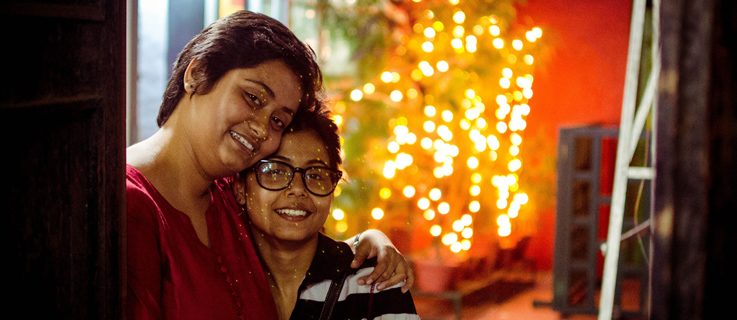Why the queer populace of Kolkata needs to reclaim its public spaces.
The 8 pm show at Vidya Cinema in central Kolkata is never really crowded. The ornamental stairs leading to the dress circle of the hall is eerily quiet, the foyer to the first-floor reception is pitch dark. This could very well be a nightmare sequence from a slasher movie, but it’s not. At a distant corner of the balcony, the white glow of cellphone display screens reveals a gaggle of smiling faces. “I come here every week, not necessarily to hook up, but to catch up with friends,” says Robin Chanda, 32, a make up professional from south Kolkata.
Welcome to Vidya Cinema, one of the last remaining queer cruising areas in the city. To the rest of Kolkata, it is one of the many rundown single-screen theatres that screen soft-porn films, but for the queer populace of the city, its name has many associations.
Being oneself without worrying
The dank air of the hall is heavy with the possibility of sex. There are men huddled in corners, there are men exchanging numbers, there are men checking each other out. “For queer people from various walks of life, cruising areas are places where they can pick up possible partners. These are also places where they can be themselves without worrying about anything else,” says Sayan Bhattacharya, an MPhil scholar from School of Women Studies, Jadavpur University.
Yet, Kolkata, which is perceived to be one of the most queer-friendly cities of the sub-continent, is slowly losing some of its most celebrated queer-friendly public spaces. “Before Vidya cinema, we would cruise at the now closed Mehta cinema. But there were frequent police raids and we would be continuously harassed by the police and authorities alike,” says Chanda.
Checkup in the park
Even before dusk settles on one of Kolkata’s most popular parks, Sarojini Udyan, the trident-shaped lights are switched on. Guards start making their rounds, swooping down on heterosexual couples who decide to cozy up little more than what they decide is publicly permissible. It’s difficult to imagine that Sarojini Udyan is one of Kolkata’s most popular gay cruising area. But deeper into the evening, things change.“It’s indeed worrying how the park is being sanitised. Even a few years ago, people could happily cruise here from the evening. The best thing about Sarojini Park is that it is very inclusive. Transgender women come here as do straight-acting men. People from all walks of life come here,”says Rudra Kishore Mondol, a Kolkata-based artist.
The “sanitisation” of Sarojini Udyan was a slow and a cold-blooded process. “First they installed lights everywhere, which I can’t really complain about because the authorities said that it was necessary to stop the criminal activities in the area. But it also meant that most transgender women and gay men wouldn't be able to cruise in such a well-lit area,” says Mondol. The next step was to close down the park by 6 pm. “How can you close down a public park by 6pm when most people start coming there only after work?” asks Mondol.
Soon, the queer crowd of the city started looking for other alternatives. “People still visit that park, but they move on to a nearby cinema complex after 6 pm. Of late the authorities have been harassing us even there,” says Bhattacharya. However, many feel that cruising spaces in urban India is mutating to take different forms. “Most young queer persons from urban spaces don't need to cruise to find possible sexual partners or friends. They have a strong virtual support system to do that. It’s people who don't have access to technology who need to fall back on these queer-friendly places,” says Bhattacharya.
Need for visibility
Which is why there is definite need for more democratic, queer-friendly spaces where people from the various walks of life can interact. “Conventional cruising itself is a very gendered thing. You wont find any spaces where lesbian or bisexual women cruise, not even in the most progressive cities. The only way we can address the need of queer friendly spaces where people can be themselves without fearing persecution, is through visibility,” says Malobika of Sappho for Equality, an organisation which works for the rights and social justice of sexually marginalized women and transmen (female to male transpersons).
It’s through public events like the pride march or Dialogues Calcutta International LGBT Film and Video Festival organised by Goethe-Institut / Max Mueller Bhavan in association with Sappho for Equality and Pratyay Gender Trust, that the queer community of the city gets a more publicly-endorsed spaces of social engagement. “Through events such as the Dialogues film festival or poetry reading sessions organised by Kolkata Rainbow Pride Festival, the community is seen, its heard. If you attend a KRPF event or the Dialogues film festival, you will see gay men, transgender persons, hijras and people with different sexual identities freely mingling. Without worrying about persecution. Of course they are not cruising areas, but they offer a sort democratic space where a lesbian women is as comfortable in her skin as a bisexual man,” says Anindya Hajra, of Pratyay Gender Trust.
(Names of certain places have been changed to protect the queer populace from persecution)
